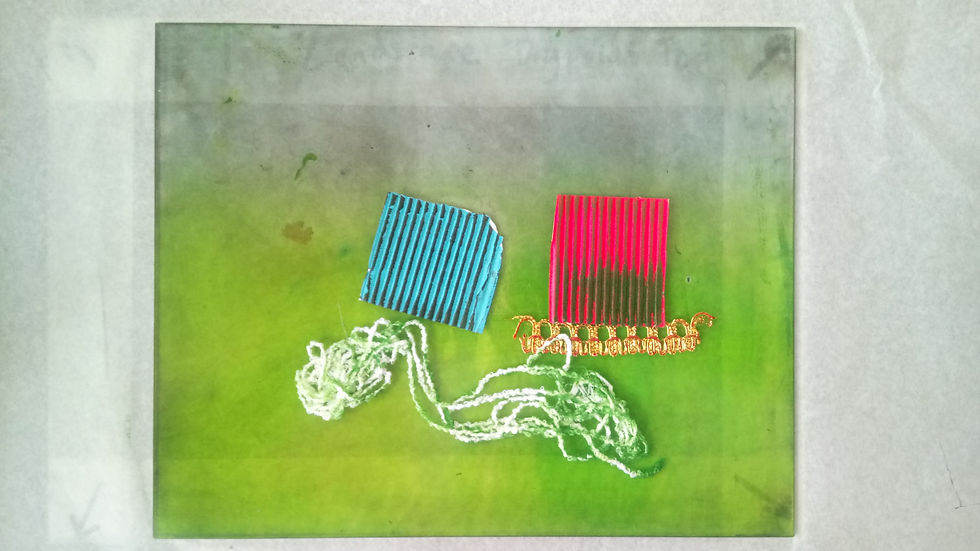The wonder of the press
- marydalton0
- Apr 1, 2019
- 3 min read
A week or so ago I went to teach the pupils of Dunannie school, in Hampshire. It was an intense and slightly crazy teaching session working with Nursery, Reception, Year 1, Year 2 and Year 3. We were working to create a large illustrated book telling the tale of Lao Lao of Dragon Mountain, a Chinese tale about dragons, paper-cutting and general adventure. We set up the Washroom Pop-Up Press in the school room of Year 3, and for two wonderful days I worked alongside these very patient, attentive and creative little printmakers.

Not only was it a huge technical challenge, to make sure the print methods I used would suit the age range, including the youngest at only 3 years old, but also a massive logistical undertaking to switch between the different workshops throughout the day, with sometimes only a 15 minute changeover for clean up. Great fun, very tiring, but hugely productive and rewarding. The prints produced were quite fantastic and told the tale of Lao Lao with imagination and finesse. Truly special.

It was the first time I had worked with the full print set up, including press, with a group of 3 year olds. I have taught full classes of year 1 before, but nursery? Nope. And that alone is a whole different ball game. When working with such little children, not only do you have to be attentive to the attention spans of the students, but also that the actual physical motor skills are not as developed as their older counterparts. When printmaking is so dependent upon tools, drawing, carving, scratching, wiping and other motor actions we take for granted, designing something that is rewarding and physically possible for the 3 year olds is a great challenge. We ended up working in groups to construct Lao Lao's garden and house, working on a sheet of plastic pre-inked with a green background. They got to choose some textural surfaces to represent their 'garden' and the house, which they were able to apply a surface ink layer with the roller, lay onto the plastic and turn the press to reveal their colourful image. The press always holds great interest for the children, and I never loose joy in seeing the faces of children pulling a print for the first time. A kind of mix of fascination, wonder, and then slight confusion as the image is backwards. But then they understand what has happened and why and they want to do it again and again and again.


I am due to be running a family printmaking session at the end of the West Dean East trail this April. The workshops will allow visitors to do some hands on printing with some beautiful nipping press, creating a jigsaw lino-cut Easter Egg (come along and see!) The presses we will have out will have gold bulbous ends to the handles, and a sense of weight and intrigue. They are incredibly simple presses, using two platens to compress the print and paper caught between, in essence, imagine a sandwich...the two slices of bread are heavy cast iron platens, and the filling is your printing plate (e.g. lino) and your paper. The sandwich gets squashed with a basic screw top handle, much like a cider press. The pressure transfers the ink onto paper producing your print. The presses are so simple, yet so effective and indeed set so nicely that even young children with less strength are able to turn the handles, give it a good squash, and produce a print. And yet again, out comes the print, and the eyes enlarge with wonder of what has just happened. It really does make expression fun and magical.
I am due to be running a family printmaking session at the end of the West Dean East trail this April. The workshops will allow visitors to do some hands on printing with some beautiful nipping press, creating a jigsaw lino-cut Easter Egg (come along and see!) The presses we will have out will have gold bulbous ends to the handles, and a sense of weight and intrigue. They are incredibly simple presses, using two platens to compress the print and paper caught between, in essense, imagine a sandwich...the two slices of bread are heavy cast iron platens, and the filling is your printing plate (e.g. lino) and your paper. The sandwich gets squashed with a basic screw top handle, much like a cider press. The pressure transfers the inkonto paper producing your print. The presses are so simple, yet so effective and indeed set so nicely that even young children with less strength are able to tunr the handles, give it a good squash, and produce a print. And yet again, out comes the print, and the eyes enlarge with wonder of what has just happened. It really does make expression fun and magical.





Comments